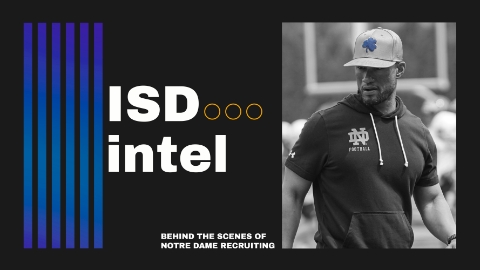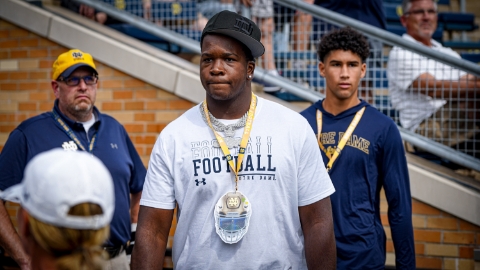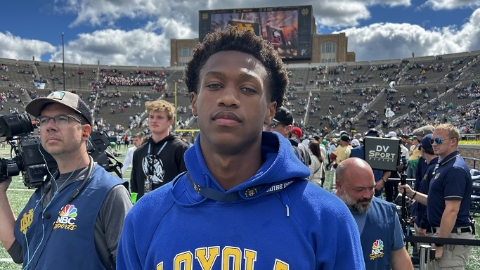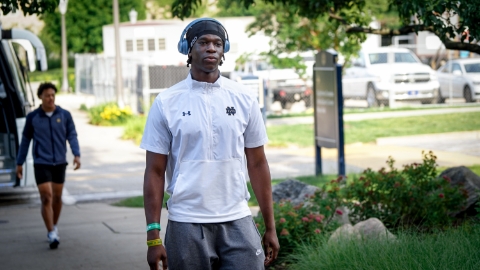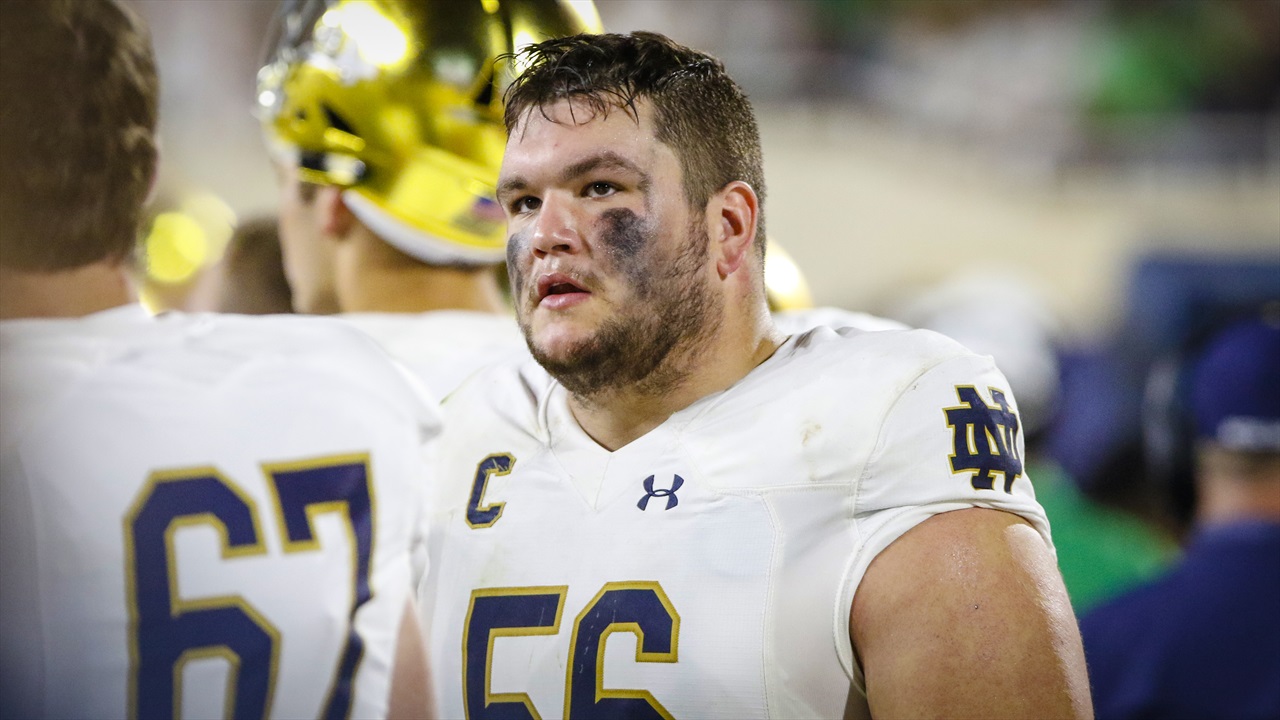
Most Notre Dame fans were excited about the finish to the class of 2018 for Notre Dame. I say most and not all because there are definitely a group of people who are disappointed about not landing prospects like Nicholas Petit-Frere and Solomon Tuliaupupu in addition to the others the Irish signed. Both are the top-100 prospects (NPF is top-50) and those are the type of prospects that everyone expects to be difference makers at the next level.
The hope is to sign more players like those two in the future, but that's not the only concern with Notre Dame recruiting. They need to make sure they are making the best evaluations to land the right ones. Then when they get to campus, they need to do a better job of developing them.
I went back to look at the recruiting classes from 2010 to 2015 for the Irish to see how well the Irish have done with their evaluations during that time period. That time period was chosen because it marks the start of the Brian Kelly era and it ends at 2015 because I feel it’s too early to say Notre Dame missed on players from the 2016 or 2017 classes due to them only being on campus for two years.
My larger focus is going to be on the 4 and 5 star recruits that they signed during that time. They signed over 70 in those classes so it’s a fair sample size. I’ll be examining it in a variety of ways with the main focus being those that they have hit on and the others they have missed with their evaluations. It’s all in an effort to see what Notre Dame can do better going forward. We're going to start by narrowing it down to top-100 prospects, though.
I'm not saying anything people don't already know when I suggest it would be positive for them to sign more top-100 recruits. While it’s something that would be welcomed by everybody if it happens, they have missed on their evaluations on far too many of them.
The Irish coaching staf signed 21 top-100 players over those six classes. The hit rate on those players has not been good enough.
To break it down a bit further, I’m splitting the 21 into four different categories.
Home runs are great players that are All-American caliber. Doubles are good players that were quality starters for multiple seasons. Singles are contributors that have made a positive impact on the field, but not very significant. Strikeouts are players who either never played or never made an impact while playing.
Home runs: DT Louis Nix (2010), DE Stephon Tuitt (2011), LB Jaylon Smith (2013), OG Quenton Nelson (2014)
This is what you hope to have out of players that are ranked so highly. All four of them were some of the best players in college football at their position. In terms of composite rankings, I wanted to note that Tuitt and Smith were top-50 prospects and Nelson and Nix weren’t (but probably should have been).
Doubles: WR TJ Jones (2010), LB Nyles Morgan (2014)
If you’re reaction isn’t “Woof” or “Ugh”, then you have to be the most positive person that’s walked this planet. Out of the rest of the top-100 prospects that Notre Dame has signed, only two were doubles? Yup, that’s it.
In a future Hits and Misses piece I’m going to go into the lack of doubles in evaluations for Notre Dame, but this is especially bleak for top-100 prospects. Whether it’s not developing players properly, finding the wrong fit, or just being incorrect with their assessment of a player, they haven’t done a good enough job of having a roster filled with good players.
Singles: DE Aaron Lynch (2011), TE Ben Koyack (2011), OL Matt Hegarty (2011), WR DaVaris Daniels (2011), S Elijah Shumate (2012), S Max Redfield (2013), TE Alize Mack (2015), RB Dexter Williams (2015), QB Brandon Wimbush (2015)
This is definitely a big issue. I understand that not everyone is going to be a home run at Notre Dame when they are a highly ranked recruit, but this list is far too long. Let me get into some explanations first with some of these guys.
Former 5 star Aaron Lynch is in this category because he did contribute for his one season at Notre Dame. He never came close to reaching his potential, but he helped them in 2011.
Koyack was a top-50 recruit who started as a senior and never made a significant impact before then. Although he was good in that one season, he’s probably more like a hit into the gap that could have been a double. He just missed turning it into two.
Most of the rest are self-explanatory with them contributing, but being erratic with their play or not playing enough. Mack, Williams, and Wimbush certainly have a chance to become doubles if they show more on the field this upcoming fall.
In terms of raw talent, this group should have been better. They weren’t, though. Notre Dame needs the last three to show out to make this not look as bad as it does now.
Strikeouts: DE Ishaq Williams (2011), WR Davonte Neal (2012), RB Greg Bryant (2013), OL Hunter Bivin (2013), WR Justin Brent (2014), OL Tristen Hoge (2015)
This happens everywhere. Sometimes highly touted prospects don’t work out for whatever the reason. Six isn’t that bad of number here. It just looks a lot worse if you put the strikeouts and singles together.
Comparing vs the Elite
I’ll be comparing against other programs with each Hits and Misses piece I do. Because these programs are the standard right now in college football with a combined nine College Football Playoff appearances between them, Ohio State, Alabama, and Clemson are the schools I’m going to compare Notre Dame with here.
From 2010-2015, Clemson signed 18 top-100 recruits. Seven of those have been home runs/All-American caliber players. Six of them have been doubles. That’s a ridiculous hit rate and speaks to how they identify and develop talent.
Ohio State signed 38 top-100 prospects over that same time period. That gives them a lot more leeway to miss because they have been able to take more swings at it. Ten of those have been home runs and only seven that I would say are doubles. They aren’t exactly connecting on all of those, but when you get that many hacks at it, you’re going to end up okay.
Alabama signed a kajillion top-100 prospects during that six class span. It’s really 61, but it made me want to puke. If you argued they have underachieved with all of that talent, it might not be incorrect. Nineteen of those players have been home runs at the college level. In my assessment, another fifteen would fall into the doubles category.
Alabama and Ohio State have clearly recruited at a different level than Notre Dame has. To be honest, I don’t think the Irish will really ever approach that level. They can close the gap, but even six top-100 level prospects a year on a regular basis is not a place where they are close to on a consistent basis. Hopefully that changes it.
It’s about more than just numbers for those programs that accumulate ridiculous amounts of top-100 talent, though. Nick Saban’s program is hitting home runs and doubles at a high rate (34 out of 61). Ohio State hasn’t done as well as Alabama, but 44.7% (17 out of 38) is still solid.
Clemson’s hit rate is borderline unsustainable, but you can’t argue with Dabo Swinney’s results so far. 13 out of 18 (72.2%) is remarkable. The fact that they have signed 16 top-100 recruits in the three most recent classes that I didn’t use for this article is a bit scary when projecting how good they will be in the future.
Yes, the Irish need to sign more of the elite of the elite recruits. But they also need to do a better job of signing the right ones and developing them to reach their potential. Notre Dame only had 6 out of 21 (28.5%) end up being home runs or doubles. No one needs to be a mathematician to tell you that is not close to being good enough to compete at the highest level.
They signed 10 top-100 recruits in the most recent three classes. It’s too early to say whether they will hit on a higher rate or not with that group. If it continues at the same rate it’s been in the six previous classes with only three of them ending up being home runs or doubles, it’s going to be tough to envision them as a Playoff team in the near future.
